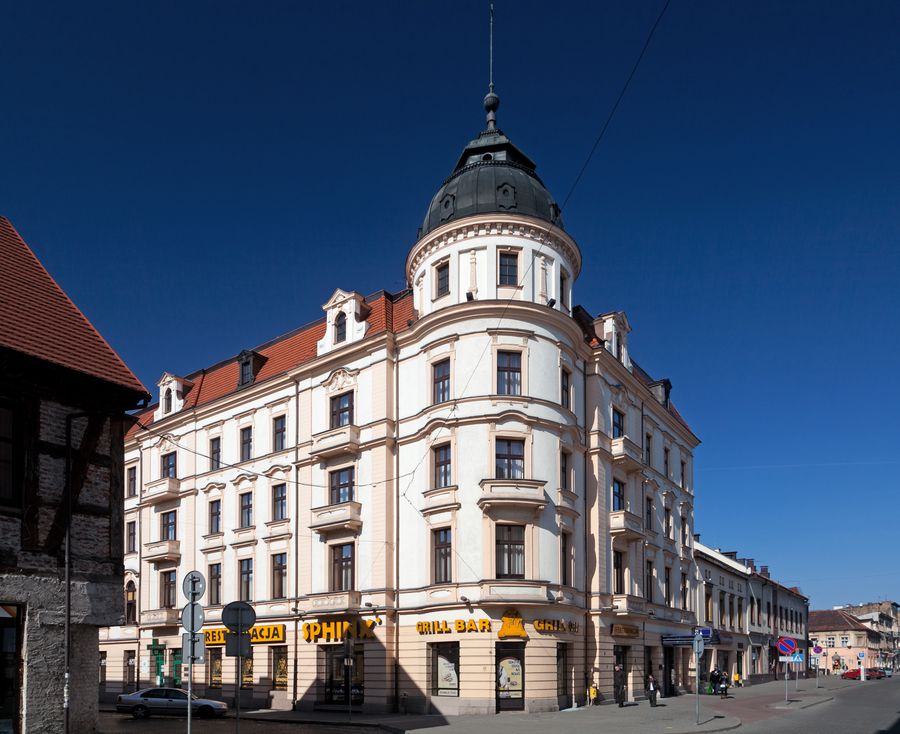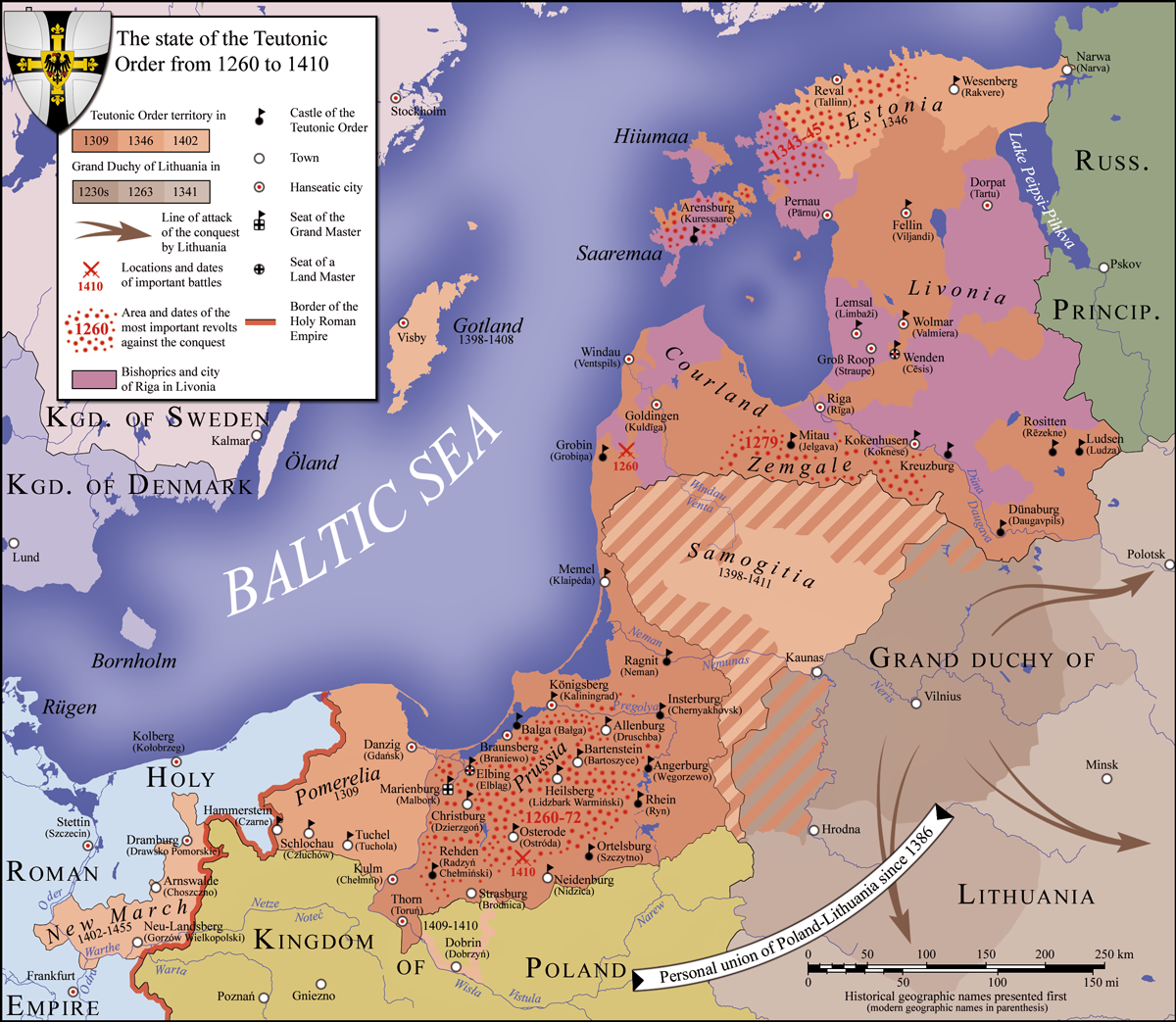|
ŇĀasin
ŇĀasin (german: Lessen) is a town in GrudzińÖdz County, Kuyavian-Pomeranian Voivodeship, Poland, with 3,271 inhabitants (2004). It is the seat of the gmina (administrative district) called Gmina ŇĀasin. It lies approximately east of GrudzińÖdz and north-east of ToruŇĄ. It is located within the historic CheŇāmno Land. History The history of ŇĀasin dates back to the rule of First Polish King BolesŇāaw I the Brave. Polish brothers Mateusz and Jakub owned land near the ŇĀasinka River (ŇĀasin). In the year 1298, it was taken from them by the Country Master of the Teutonic Order Meinhard von Querfurt and given to Jan de Nemore, who founded the village of ŇĀasin. Also in 1298, the town received German Magdeburg law city rights from the monastic state of the Teutonic Knights in which it was located. In 1454, King Casimir IV Jagiellon reincorporated the CheŇāmno Land into the Kingdom of Poland upon the request of the Prussian Confederation, however, ŇĀasin itself was captur ... [...More Info...] [...Related Items...] OR: [Wikipedia] [Google] [Baidu] |
Gmina ŇĀasin
__NOTOC__ Gmina ŇĀasin is an urban-rural gmina (administrative district) in GrudzińÖdz County, Kuyavian-Pomeranian Voivodeship, in north-central Poland. Its seat is the town of ŇĀasin, which lies approximately east of GrudzińÖdz and north-east of ToruŇĄ. The gmina covers an area of , and as of 2006 its total population is 8,288 (out of which the population of ŇĀasin amounts to 3,276, and the population of the rural part of the gmina is 5,012). Villages Apart from the town of ŇĀasin, Gmina ŇĀasin contains the villages and settlements of Bogdanki, BoŇľe Pole, GoczaŇāki, Gordanowo, Hermanowo, Huta-Strzelce, Jakubkowo, Jankowice, KozŇāowo, Ludwichowo, MaŇāe Szczepanki, Nogat, Nowe BŇāonowo, Nowe Jankowice, Nowe Mosty, Plesewo, PrzesŇāawice, Stare BŇāonowo, Ňöwińôte, Szczepanki, Szonowo Kr√≥lewskie, Szonowo Szlacheckie, SzynwaŇād, SzynwaŇādzik, Wybudowanie ŇĀasiŇĄskie, Wydrzno, Zawda and Zawdzka Wola. Neighbouring gminas Gmina ŇĀasin is bordered by the gmin ... [...More Info...] [...Related Items...] OR: [Wikipedia] [Google] [Baidu] |
GrudzińÖdz County
GrudzińÖdz County ( pl, powiat grudzińÖdzki) is a unit of territorial administration and local government (powiat) in Kuyavian-Pomeranian Voivodeship, north-central Poland. It came into being on January 1, 1999, as a result of the Polish local government reforms passed in 1998. Its administrative seat is the city of GrudzińÖdz, although the city is not part of the county (it constitutes a separate city county). The only towns in GrudzińÖdz County are ŇĀasin, which lies east of GrudzińÖdz, and RadzyŇĄ CheŇāmiŇĄski, south-east of GrudzińÖdz. The county covers an area of . As of 2019 its total population is 40,181, out of which the population of ŇĀasin is 3,254, that of RadzyŇĄ CheŇāmiŇĄski is 1,847, and the rural population is 35,080. Neighbouring counties Apart from the city of GrudzińÖdz, GrudzińÖdz County is also bordered by Kwidzyn County to the north, IŇāawa County, Nowe Miasto County and Brodnica County to the east, WńÖbrzeŇļno County to the south, and CheŇāmno County and Ňö ... [...More Info...] [...Related Items...] OR: [Wikipedia] [Google] [Baidu] |
Landkreis Graudenz
The district of Graudenz was a Prussian district in the administrative region of Marienwerder that existed from 1818 to 1920. It belonged to the province of West Prussia until 1829 and then again from 1878 to 1920. Between 1829 and 1878, it belonged to the Province of Prussia. It was located in the part of West Prussia that fell to Poland after the World War I in 1920 through the Treaty of Versailles. The city of Graudenz, was part of the district until 1900, after which it formed its own independent urban district. From 1939 to 1945, the district was re-established in occupied Poland as part of the newly established Reichsgau Danzig-West Prussia. Today this area lies in the Polish Kuyavian-Pomeranian Voivodeship. History The area of the future Graudenz district became part of Prussia through the First Partition of Poland in 1772. As part of the historical Kulmerland, it belonged to the Kulm district from 1772. In the course of the Prussian administrative reforms, on Apr ... [...More Info...] [...Related Items...] OR: [Wikipedia] [Google] [Baidu] |
Kuyavian-Pomeranian Voivodeship
Kuyavian-Pomeranian Voivodeship, also known as Cuiavian-Pomeranian Voivodeship or simply Kujawsko-Pomorskie, or Kujawy-Pomerania Province ( pl, wojew√≥dztwo kujawsko-pomorskie ) is one of the 16 voivodeships (provinces) into which Poland is divided. It was created on 1 January 1999 and is situated in mid-northern Poland, on the boundary between the two historic regions from which it takes its name: Kuyavia ( pl, Kujawy) and Pomerania ( pl, Pomorze). Its two chief cities, serving as the province's joint capitals, are Bydgoszcz and ToruŇĄ. History The Kuyavian-Pomeranian Voivodeship was created on 1 January 1999, as a result of the Polish local government reforms adopted in 1998. It consisted of territory from the former Bydgoszcz, ToruŇĄ and WŇāocŇāawek Voivodeships. The area now known as Kuyavia-Pomerania was previously divided between the region of Kuyavia and the Polish fiefdom of Royal Prussia. Of the two principal cities of today's Kuyavian-Pomeranian voivodeship, one ( ... [...More Info...] [...Related Items...] OR: [Wikipedia] [Google] [Baidu] |
Thirteen Years' War (1454‚Äď1466)
The Thirteen Years' War (german: Dreizehnj√§hriger Krieg; pl, wojna trzynastoletnia), also called the War of the Cities, was a conflict fought in 1454‚Äď1466 between the Prussian Confederation, allied with the Crown of the Kingdom of Poland, and the State of the Teutonic Order. The war began as an uprising by Prussian cities and local nobility to win independence from the Teutonic Knights. In 1454 Casimir IV married Elisabeth of Habsburg and the Prussian Confederation asked Poland's King Casimir IV Jagiellon for help and offered to accept the king as protector instead of the Teutonic Order. When the King assented, war broke out between supporters of the Prussian Confederation, backed by Poland, and backers of government by the Teutonic Knights. The Thirteen Years' War ended in the victory of the Prussian Confederation and Poland and in the Second Peace of Thorn (1466). This was soon followed by the War of the Priests (1467‚Äď1479), a drawn-out dispute over the independ ... [...More Info...] [...Related Items...] OR: [Wikipedia] [Google] [Baidu] |
CheŇāmno Land
CheŇāmno land ( pl, ziemia cheŇāmiŇĄska, or Kulmerland, Old Prussian: ''Kulma'', lt, Kulmo Ňĺemńó) is a part of the historical region of Pomerelia, located in central-northern Poland. CheŇāmno land is named after the city of CheŇāmno (historically also known as Culm). The largest city in the region is ToruŇĄ; another bigger city is GrudzińÖdz. It is located on the right bank of the Vistula river, from the mouth of the Drwńôca (southern boundary) to the Osa (northern). Its eastern frontier is Lubawa Land. The region, depending on the period and interpretation, may be included in other larger regions: Mazovia, Pomerania or Prussia. Currently in Poland it is classified as part of Pomerania, due to strong connections with GdaŇĄsk Pomerania in recent centuries, with which it is collectively called the Vistula Pomerania (''Pomorze NadwiŇõlaŇĄskie''), although it also has close ties with neighboring Kuyavia. As a result it forms part of the Kuyavian-Pomeranian Voivodship, ... [...More Info...] [...Related Items...] OR: [Wikipedia] [Google] [Baidu] |
Royal Prussia
Royal Prussia ( pl, Prusy Kr√≥lewskie; german: K√∂niglich-Preu√üen or , csb, Kr√≥lewscz√© Pr√ęs√ę) or Polish PrussiaAnton Friedrich B√ľsching, Patrick Murdoch. ''A New System of Geography'', London 1762p. 588/ref> (Polish: ; German: ) was a province of the Crown of the Kingdom of Poland, which was established after the Second Peace of Thorn (1466) from territory in Pomerelia and western Prussia which had previously been part of the State of the Teutonic Order. Royal Prussia retained its autonomy, governing itself and maintaining its own laws, customs, rights and German language. In 1569, Royal Prussia was fully integrated into the Crown of the Kingdom of Poland and its autonomy was largely abandoned. As a result, the Royal Prussian parliament was incorporated into the Sejm of the Polish‚ÄďLithuanian Commonwealth. In 1772, the former territory of Royal Prussia was annexed by the Kingdom of Prussia and subsequently re-organized into the province of West Prussia. This occurre ... [...More Info...] [...Related Items...] OR: [Wikipedia] [Google] [Baidu] |
Prussian Confederation
The Prussian Confederation (german: Preu√üischer Bund, pl, ZwińÖzek Pruski) was an organization formed on 21 February 1440 at Kwidzyn (then officially ''Marienwerder'') by a group of 53 nobles and clergy and 19 cities in Prussia, to oppose the arbitrariness of the Teutonic Knights. It was based on an earlier similar organization, the Lizard Union established in 1397 by the nobles of CheŇāmno Land. In 1454, the leader of the Confederation, Johannes von Baysen (Jan BaŇľyŇĄski), formally asked King Casimir IV Jagiellon, to incorporate Prussia into the Kingdom of Poland. This marked the beginning of the Thirteen Years' War between the Order's State and Poland, with the cities co-financing the military costs of the latter. Background According to the 1411 First Peace of Thorn which followed the Teutonic Knights' defeat in the Battle of Grunwald, the Teutonic Order had to pay high reparations to the Kingdom of Poland. The monastic state imposed high taxes on the cities to ra ... [...More Info...] [...Related Items...] OR: [Wikipedia] [Google] [Baidu] |
CheŇāmno Voivodeship
The CheŇāmno Voivodeship () was a unit of administrative division and local government in the Kingdom of Poland since 1454/1466 until the Partitions of Poland in 1772/1795. Together with the Pomeranian and Malbork Voivodeships and the Prince-Bishopric of Warmia it formed the historical province of Royal Prussia. Its capital was at CheŇāmno (german: link=no, Kulm). History The ''Land of CheŇāmno'' (later known in German as Kulmerland) had been part of the Polish Duchy of Masovia since 1138. It was occupied by pagan Old Prussian tribes in 1216, who struggled against their Christianization instigated by Bishop Christian of Oliva. After several unsuccessful attempts to reconquer CheŇāmno, Duke Konrad I of Masovia in 1226 called for support by the Teutonic Knights, who indeed approached and started a Prussian campaign, after the duke promised them the unshared possession of the CheŇāmno territory as part of the Order's State. In the course of the Order's decline after the 1410 B ... [...More Info...] [...Related Items...] OR: [Wikipedia] [Google] [Baidu] |
Voivodeships Of Poland
A voivodeship (; pl, województwo ; plural: ) is the highest-level administrative division of Poland, corresponding to a province in many other countries. The term has been in use since the 14th century and is commonly translated into English as "province". The administrative divisions of Poland, Polish local government reforms adopted in 1998, which went into effect on 1 January 1999, created sixteen new voivodeships. These replaced the 49 subdivisions of the Polish People's Republic, former voivodeships that had existed from 1 July 1975, and bear a greater resemblance (in territory, but not in name) to the voivodeships that existed between 1950 and 1975. Today's voivodeships are mostly named after historical and geographical regions, while those prior to 1998 generally took their names from the cities on which they were centered. The new units range in area from under (Opole Voivodeship) to over (Masovian Voivodeship), and in population from nearly one million (Opole Voivodes ... [...More Info...] [...Related Items...] OR: [Wikipedia] [Google] [Baidu] |
Greater Poland Province Of The Polish Crown
, subdivision = Province , nation = Poland , year_start = , event_end = Third Partition of Poland , year_end = , image_map = Prowincje I RP.svg , image_map_caption = , capital = PoznaŇĄ , political_subdiv = 13 voivodeships and one duchy , common_name = Greater Poland Province ( pl, Prowincja Wielkopolska) was an administrative division of the Crown of the Kingdom of Poland from 1569 until 1795. The name of the province comes from the historic land of Greater Poland. The Greater Poland Province consisted initially of twelve voivodeships (after 1768 thirteen voivodeships)Lucjan Tatomir, ''Geografia og√≥lna i statystyka ziem dawnej Polski'', Drukarnia "Czasu" W. Kirchmayera, Krak√≥w, 1868, p. 147 (in Polish) and one duchy: # BrzeŇõńá Kujawski Voivodeship # CheŇāmno Voivodeship # Gniezno Voivodeship, est. in 1768 # InowrocŇāaw Voivodeship # Kalisz Voiv ... [...More Info...] [...Related Items...] OR: [Wikipedia] [Google] [Baidu] |
.jpg)






